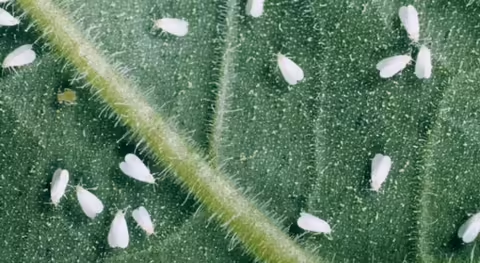Don’t fret over whitefly infestations on flowers as these latecomers to the landscape most likely don’t require control because they won’t make it through the Illinois winter. Only plants that make the journey back inside should be monitored and or treated for these insect pests.
Clouds of whiteflies are a common occurrence in the mid fall months on some of our favorite garden plants. Tiny pure white moth-looking flies ascend from even the most minor of disturbances of flowers and plants. These true bugs, not flies, are sap suckers like aphids. Like aphids, large infestations of whitefly produce sticky honey dew that can cause plants to turn yellow and drop its leaves. Damage usually occurs when both life stages are feeding nymphs and adults. The nymphs are the most damaging to plants. These can be hard to find and identify.
Whitefly reaches adult hood in as little as three weeks but can’t be considered a serious garden pest because it doesn’t have enough time to build up populations in your garden. Whitefly would be more of a concern on tomatoes in the spring. The populations have been building all summer and the plants in the Illinois landscape are currently stressed from lack of water.
Adult whiteflies have settled on marigolds, salvia, and mandevilla in my porch pots. I have seen many years of infestations on blackberries and raspberries at the Refuge Food Forest in Normal. The mandevilla on my porch could be saved and used for a future propagation workshop.
Steps to save the whitefly infested houseplant like mandevilla.
Monitor whitefly infestations by looking on the undersides of the lower leaves on the plant. The nymphs do not look like insects at all but a translucent spot on the leaf. Refer to article for image of nymph.
- Clean leaves and flowers around plant and at base.
- Continue good watering and fertilizing schedule.
- If plant has issues in a few weeks, either cut back and spray or throw away. It is important to cut back the plant before treatment for two reasons: One is coverage of plant surfaces is better and two, flowers should be removed as not to contaminate future pollinator visitors.
University of Illinois Home Yard and Garden Pest Newsletter recommendation is: Good thorough coverage with sprays of insecticidal soap or summer spray oil. Apply weekly, two or three times. Good for flowering annuals, succulents or houseplants that will be overwintered.
ABOUT THE AUTHOR: Kelly Allsup is a Horticulture Educator for University of Illinois Extension serving Livingston, McLean and Woodford Counties. She meets the educational needs of her community, including local chapters of Master Gardener and Master Naturalist volunteers, through expertise in home horticulture and entomology. Her passion for ecologically-friendly gardening and all things plants makes her a dynamic speaker on topics that range from beneficial insects, growing vegetables and fruits, to urban trees.
